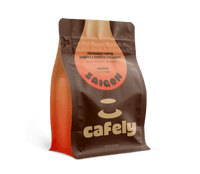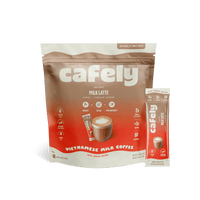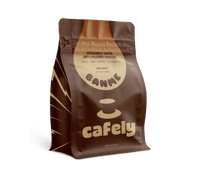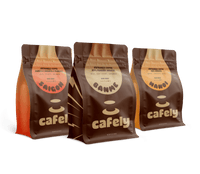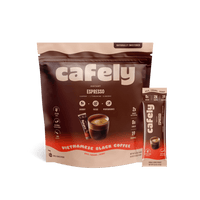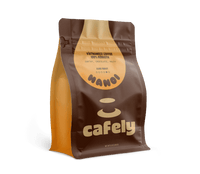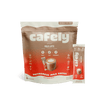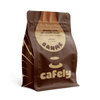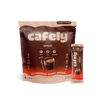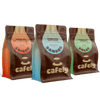A French press, also known as a press pot or plunger pot, is a staple for coffee drinkers. Its strengths are its simplicity and versatility.
The French Press makes it easy to adjust the strength of your brew by changing the amount of coffee.
The French press employs immersion-style brewing — in which the coffee grounds are fully immersed in water. This method efficiently extracts alkaloids, oils, and terpenes suspended in the bean for a full flavor profile.

French Press Brewing Specs
- Brew Time: 4 minutes
- Coffee/Water Ratio: 1:12
- Grind: Coarse (like sea salt)
- Water Temperature: 208ºF (98ºC)
- Recommended Coffee: Da Lat
French Press Step Summary
- Measure & grind your coffee
- Add coffee grounds & water
- Wait 4–5 minutes for your coffee to brew
- Plunge, pour, & enjoy!
Tools You’ll Need
To brew coffee using a French press, you’ll need the following items/ingredients:
- French Press — Available in glass, metal, or plastic and in sizes ranging from 1 serving all the way up to 6 cups of coffee.
- High-Quality Coffee — Opt for fresh-roasted, high-quality coffee for best results. Works equally well with both robusta coffee and arabica beans.
- Coffee Grinder — A burr grinder provides the best grind consistency, but blade grinders or a small blender work great as well. Aim for a coarse grind similar to the consistency of sea salt.
- Hot Water — For French press brewing, you’ll want to opt for a ratio of around 1:12 coffee to water. The total amount of water and coffee will depend on the size of your press.
Step-By-Step Instructions: French Press
Here’s a simple process for brewing coffee using a French Press.
Note: Coffee is a personal experience, so there’s no wrong way to prepare it. The guide below provides ideal ratios and steps for making immersion coffee with a French press — but feel free to make it your own using different water ratios.
Step 1: Measure & Grind Your Coffee

The amount of coffee you’ll need will depend on the size of your French press (chart below).
Grind your coffee beans using a coffee grinder, or opt for pre-ground coffee beans to skip this step entirely.
Aim for a coarse grind with a similar consistency to sea salt. If you grind too finely, you risk over-extracting the coffee and producing overly acidic or bitter flavors.
French Press Coffee to Water Ratios:
|
French Press Size |
Servings |
Coffee |
Water |
|
3 Cups (12 oz | 350 mL) |
1 serving |
17 grams (2-3 tbsp) |
7.5 oz (220 mL) |
|
4 Cups (17 oz | 500 mL) |
2 servings |
27 grams (4-5 tbsp) |
12 oz (350 mL) |
|
8 Cups (34 oz | 1000 mL) |
4 servings |
54 grams (8-10 tbsp) |
22 oz (650 mL) |
|
12 Cups (51 oz |1500 mL) |
6 servings |
80 grams (12–15 tbsp) |
34 oz (1000 mL) |
Step 2: Add Coffee Grounds & Water

Add your coffee directly into the bottom of the French press and fill it up with your water. Add the top of the French press with the plunger fully retracted to retain heat.
Step 3: Wait For Your Coffee To Brew

Set a timer for 4 minutes to let the water extract all the coffee’s desired flavors but leave behind the unwanted acidic and bitter flavors.
You can simply let it sit and extract or stir it once or twice using the plunger.
We like to push the plunger at 0 minutes, then again at 2 minutes, and one final time at the 4-minute mark to ensure even extraction.
Step 4: Plunge & Pour

At the 4-minute mark, push the plunger down to separate the coffee from the water and pour it into your mug.
Sweeten using milk or milk alternatives, sugar, honey, or your preferred sweetener to taste and enjoy!
Expert Tips: French Press
Making coffee with a French press couldn’t be simpler, but there are a few extra steps you can take to get even more out of your extraction.
All of these steps are optional — but for the coffee nerds out there like us, these small tweaks will make a noticeable improvement in your final brew.
1. Preheat Your Press
Prior to adding the coffee to your French press, you can give it a rinse with hot water to preheat the device. This ensures that when you add the water, you maintain the optimal temperature for extraction.
Add some water to the press, give it a swirl, and dump it out after a few seconds.
2. Skim Oils & Grounds From the Top With a Spoon
Right before the final press with the plunger, after 4 minutes, you can take the lid and plunger out and skim off the foam on the top. Most of the coffee grounds will settle at the bottom, while proteins and fats will form a foam at the top.
Skimming this off the top before the final plunge helps produce a cleaner, brighter cup of coffee.
3. Plunge Periodically While You Brew
You don't need to stir your coffee or push the plunger (some people even prefer to leave it to sit without interfering) — but you can get a richer, darker extraction by plunging periodically. We recommend using the plunger once at the very beginning (0 minutes) and halfway through (2 minutes).
4. Change Ratios According to Which Beans You’re Using
Different types of coffee benefit from different brew styles. One of the major advantages of the French press is its adaptability. For example, you can brew a much stronger Vietnamese-style coffee using Coffea robusta beans by using about ⅓ the water you would for 100% arabica coffee.
You can also reduce the amount of coffee to produce a more “tea-like” coffee experience that resembles Ethiopian Yiergocheffe or a lighter pour-over extraction of light or medium-roast beans by steeping the coffee for 2 or 3 minutes instead of 4.
5. Use An Insulated French Press
The water you add to your French Press will rapidly start to cool while the coffee extracts over 4 minutes. Preheating your press helps reduce the initial drop but does little to stop the gradual decline as your coffee steeps. An insulated French press solves this problem and ensures the ideal extraction temperature throughout the brewing process.
6. Make Sure Your French Press is Completely Clean Before Use
Exhausted coffee grounds often get stuck in small crevices of the metal filter while you brew, especially when the filter starts to break down over many uses. When cleaning your press between steeps, it’s important to separate the filter components to remove any residual grounds.
Leftover bits of coffee from old brews will infuse into your coffee and impart bad and bitter flavors.
7. Change The Filter Screen When it Starts to Degrade
Any good French press will come with replaceable screens. The lifespan of most French press filters should last several hundred brews, but eventually, the screen becomes mishappen. This can allow grounds to escape while you plunge, leaving bits of coffee behind in the final brew. These chunks of coffee will continue to infuse into your coffee, making the final brew chalky and bitter.
If you notice pieces left over in the bottom of your cup when you're done drinking, it might be time to replace your filter.
History of the French Press
Credit for the true inventor of the French press is still hotly disputed — claimed by both the French and the Italians.
It's believed to have been invented in the early 19th century when a Frenchman used a metal or cheesecloth screen to press down on coffee grounds steeped in boiling water. The first patent for a French press was filed by an Italian designer, Attilio Calimani, in 1929, who refined the design to its current form. This doesn't necessarily mean he invented it, but the official credit appears to go to the Italians.
Over the years, the French press has seen various improvements and iterations but remains mostly faithful to the original designs. A true classic.
FAQs & Troubleshooting: French Press

1. What is the best ratio for a French press?
The optimal coffee-to-water ratio for brewing with a French press is 1:12. This means for every tablespoon of coffee (~10 grams), you should use 0.5 cups of water (120 mL).
A typical 4-cup French press should use 4–5 tablespoons of coffee with 4 cups of water.
2. How long should I let my coffee steep in the French press before pressing?
You should leave your coffee to brew in the French press for 3-4 minutes before pressing. This allows for full extraction of the coffee flavors without over-extracting and causing bitterness. Some people like to stir the coffee 1–3 times before pressing; others prefer to just let it sit.
3. What kinds of coffee can you brew in a French press?
A French press is versatile and can brew both robusta and arabica beans effectively. It’s suitable for all types of coffee, allowing for the preparation of teas or cold brew coffee as well. You can increase or decrease the potency of your coffee by using higher or lower coffee-to-water ratios as well.
4. What type of coffee grind should I use with a French Press?
A coarse grind, similar to the consistency of sea salt, is ideal for use with a French press. A coarse grind helps prevent over-extraction and ensures the coffee doesn’t become overly acidic or bitter.
5. What is the best water temperature for French Press coffee?
Your water temperature should be between 195°F to 208°F (90°C to 98°C) when brewing with a French press. Water that's too hot can over-extract the coffee, leading to bitterness, while water that's too cool may result in under-extraction, producing a weak flavor.
6. Do I need to stir the coffee and water mixture?
You don’t need to stir your French press coffee, but many people find it produces a more even extraction. Stir right after adding the hot water (0 minutes), in the middle (2 minutes), and right at the end before plunging (4 minutes).
8. Can I make tea in a French Press?
Yes! A French press can also be used to steep loose-leaf tea. The process is similar to brewing coffee, but the steeping time and temperature will vary depending on the type of tea.
Water remaining in the French press will continue to steep — so try to empty your French press completely once it’s finished brewing. Lighter teas like white tea or green tea may become bitter and astringent if allowed to steep too long in a French press.
9. Why is my French Press coffee bitter?
Bitterness can result from over-extraction, which occurs when the coffee grounds steep for too long or the grind is too fine. Adjusting the steeping time, using a coarser grind, or decreasing the temperature of your water can help reduce bitterness.
10. Can I reuse coffee grounds in a French Press?
While it's technically possible to reuse coffee grounds, this is not recommended. The second brew will be significantly weaker and may impart an unpleasant bitter taste due to an overabundance of bitter, chlorogenic and quinic acids left over from the initial steep.
